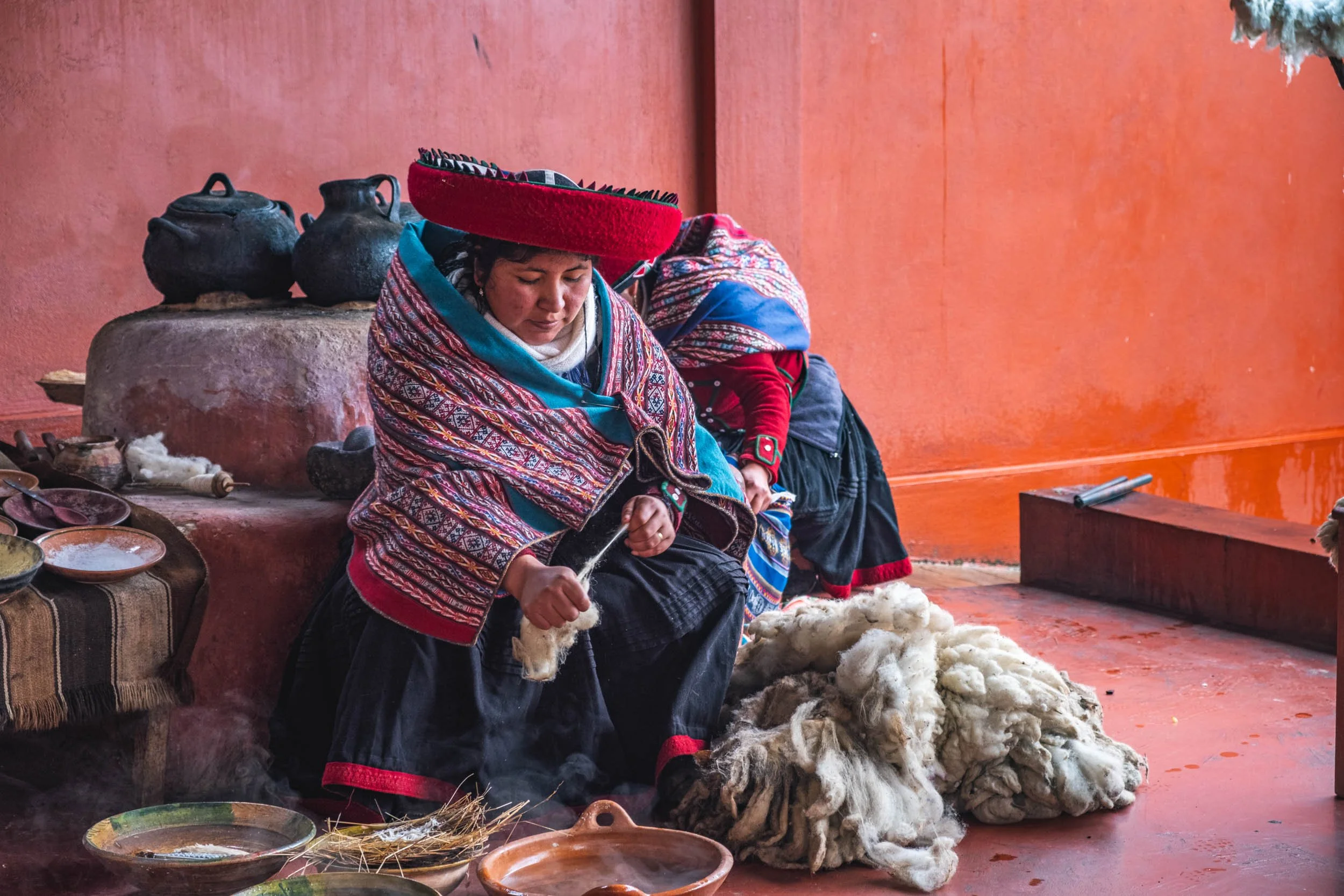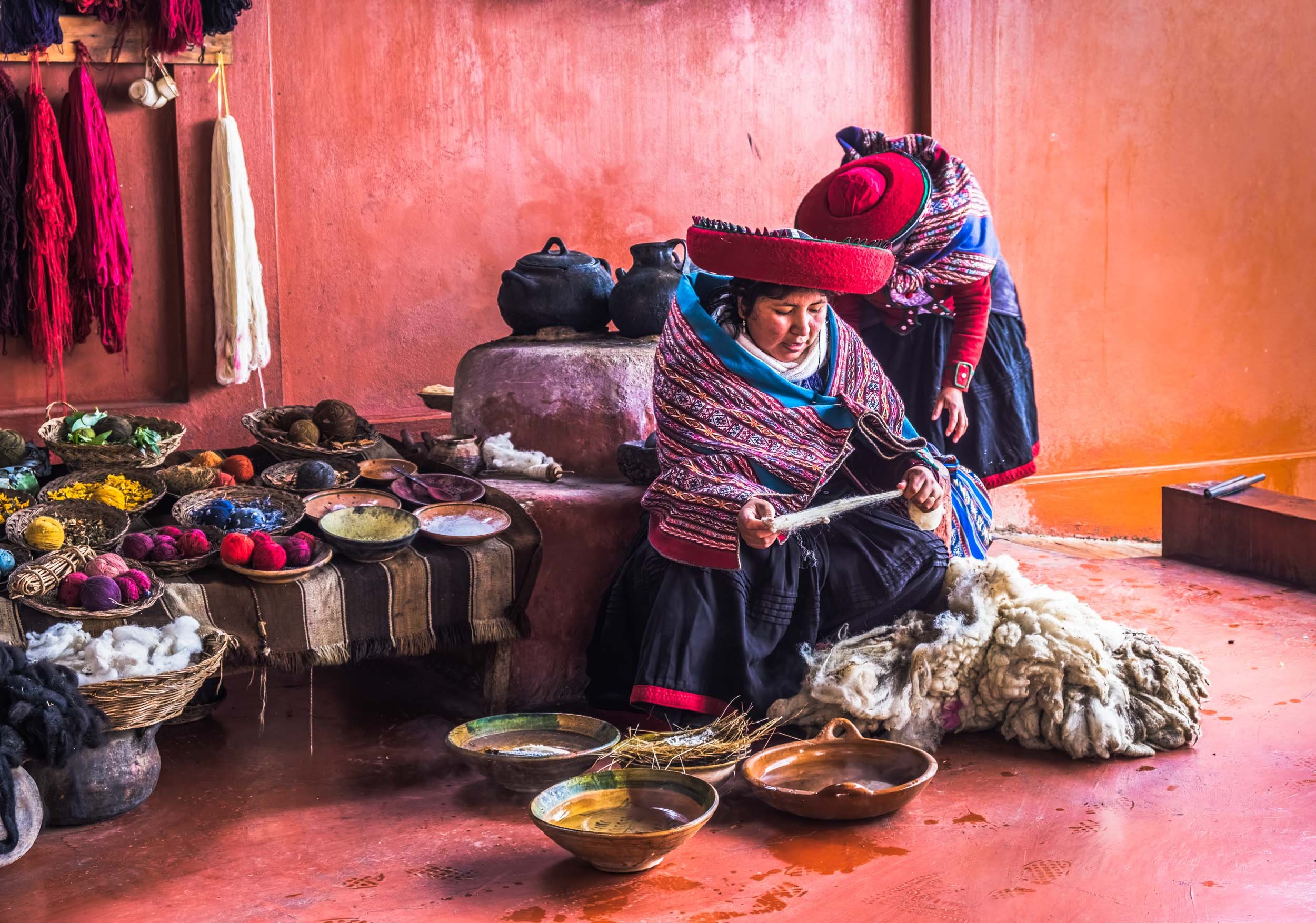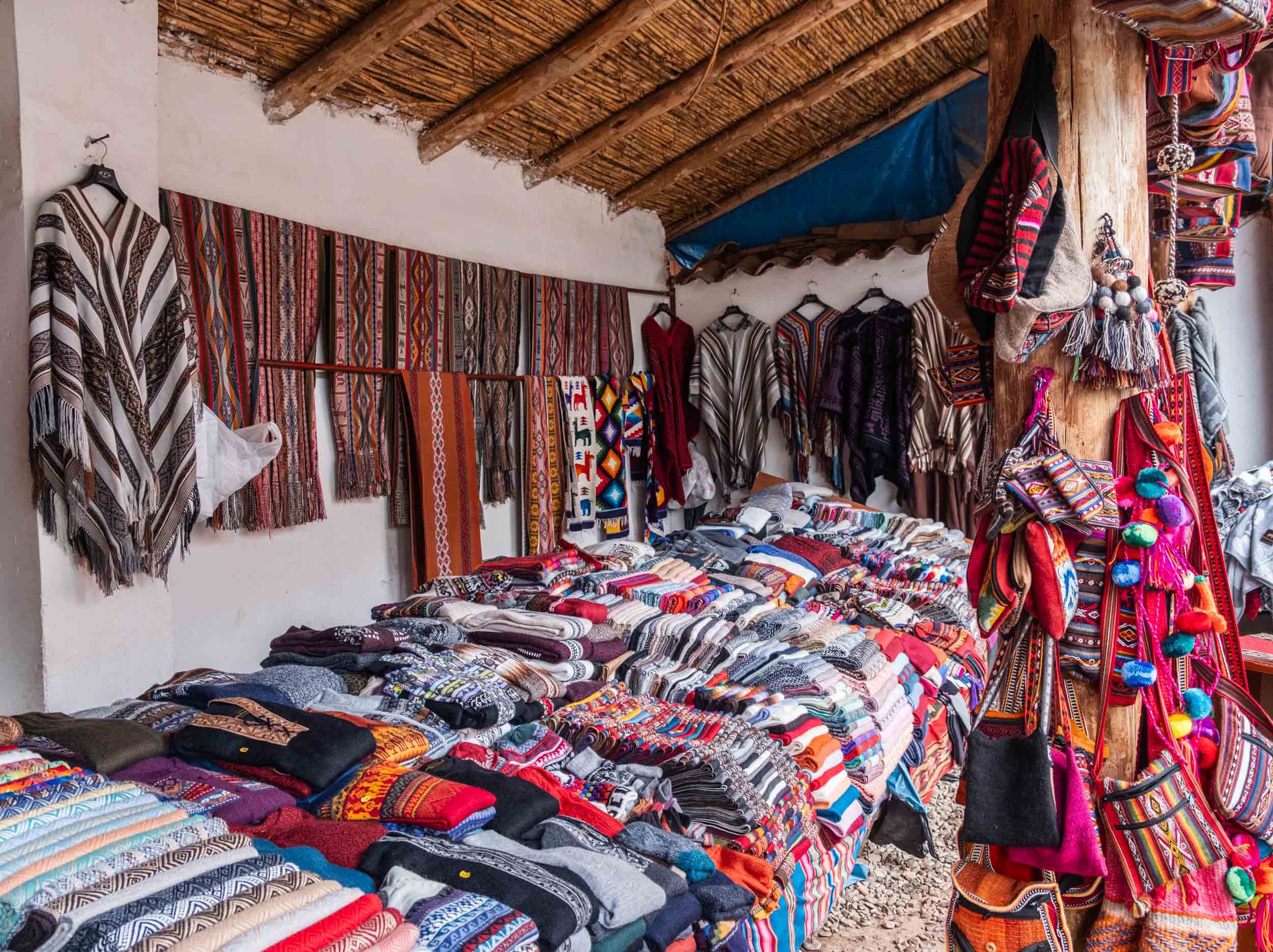Machu Picchu - click on the picture for more images

Katie and Jill hanging out with an alpaca
After arriving in Cusco from Lima, we went exploring the town. Near the main square in Cusco, Katie and Jill spotted a local farmer with one of her alpacas. Super cute. I offered her $2 to take her picture….she wanted $5! HA…silly me! And yes, the local Peruvian women still wear the traditional dress, complete with beautiful skirts (Polleras), shawls (Mantas) and of course, the cool hats (Montera’s). Depending on the region, the clothing would vary slightly.

Claudia and the baby alpaca
Just down the street from the other woman and her nearly full-grown alpaca, sat her daughter with a baby alpaca. You had to look twice to make sure it wasn’t a doll…it never moved. Check out the amazing colors of her handmade clothing. They use only dies made from local ingredients.

HI....come over and pet me!
On our first day exploring Cusco with our guide, Vidal, we visited a local llama and alpaca farmers collective. That morning, it snowed in May for the first time in 18 years. The animals of course, loved it. They raise llamas and alpacas and the local women hand-craft the amazing textiles for sale in the store (yes…we bought some). They use the fleece from the alpacas and the softest (and most expensive) garments are made from 100% pure baby alpaca wool, which is only from the first shearing at around six months of age. I thought it was softer than cashmere….amazing.

Yippee...it snowed and I'm happy!
A llama/alpaca petting zoo. Since none of us had ever seen a llama or an alpaca in person, we didn’t know what to expect. They were super friendly and came right over to the fence. I’ve since learned that the alpacas are smaller and more gentle and used only for the fleece. The llamas, on the other hand, are larger, stronger and are used for pack animals and meat production.

Here's how you spin llama wool with no spinning wheel to help
The woman in this picture was demonstrating how they dye and spin the wool to get it ready. It’s very labor-intensive…they wash it three times to get rid of all the impurities, then dye it with hand-crafted dyes made from local plants and bugs (yep!). Check out the smoking pot in front of her where she washed the wool. She was very fluent in English and was training to become their marketing person.

The "factory" at work
The baskets in the background were full of already dyed wool, as well as the berries, flowers and bugs from which they make the dyes. She showed us how they use a local bug (barely an 1/8” in diameter) to make the unique red dye. Hanging on the wall was previously dyed wool that was drying.

When "hand-made" really means hand-made!
When you see the finished products, it’s hard to believe that these amazingly talented ladies make them from scratch, using centuries-old techniques and hand-held looms. It was fascinating to watch. They said it can take a week or more to make one table runner or quilt.

Table runner anyone?
We stood and watched this amazing lady using her simple, hand-held loom to work on a new table runner. How she gets the lines so straight and the designs to fit perfectly is a mystery. True artists.

The Shop - prepare for sensory overload
Underneath this simple shed, the local families display and sell their amazing products….blankets, purses, quilts, ponchos, hats, socks, table cloths, sweaters (they were amazing) and much more. The prices were so reasonable, we felt almost guilty paying what they were asking. Once back in the big cities like Lima, double or triple these prices. Katie, Jill and Claudia all bought some great stuff. If we lived in a cooler climate, I would have bought a sweater for sure…they were beautiful.

So many choices...so little time!
Here’s a shot of Claudia picking out a table runner and Katie getting ready to buy a blanket. We could have spent a lot more time and a lot more money there! Good thing we had to head to our next stop….the amazing salt flats of Maras.

The Maras Salt Flats - The White Gold of the Andes
The salt harvested at Maras is a community effort to support families whose land isn’t very productive due to the salinity. About 650 local families work thousands of these salt pools and the income from the sale of the finished salt helps provide them with additional income. We purchased some of the salt and wished we’d bought more, as it’s delicious and totally unique to that area. The Incas discovered that a stream flowing out of the mountain was very high in salinity. They were the first known people to harvest it.

The route to Machu Picchu starts here in the town of Aguas Calientes
This is a view down the main street, showing the Peru Rail tracks that run right down the middle of the town, as well as some of the shops and restaurants along the street. We loved this town…full of really fun people, great cocktails (some of the best Pisco Sours we had) and some beautiful hotels right on the banks of the river. A special place for sure.

Discussing the schedule for the next day
Having a quick lunch at Munaycha in Agua Calientes with our guide Vidal (what a super guy!). Busy day tomorrow….as we head to Machu Picchu. We loved this town. Really fun waiters and great food (which became a pattern in Peru…the food was exceptional. The back patio overlooks the Urubamba River.

We Made It!
After a journey of 3,500 miles and a combination of planes, trains, cars and buses….you walk up a steep set of ancient stairs and emerge onto a grassy area and….you look out at this. It literally takes your breath away and you realize that everything you’ve read and all the pictures don’t even begin to do it justice. It’s absolutely magnificient.

Let the tours begin!
A group of tourists can be seen heading into the massive site. The Peruvian government now limits the number of people who can visit the site to approximately 2,500 daily. Most groups (including us) use a local registered Peruvian guide on at least the first day. The knowledge they have about the site is extraordinary and they’re understandably very proud of it and the history it represents.

The Temple of The Sun
This room is the most important building at Machu Picchu. Only the high priests and other spiritual leaders were allowed inside. The windows are aligned with the Summer and Winter solstice. Another shot I took shows how this room was built on top of existing stones in the mountain. This is significant, as the Incas worship the Pachamama (Mother Earth) and believe she controls many things, like planting, fertility and even earthquakes (Machu Picchu sits atop two fault lines).

A view of the sacred valley
Claudia, Katie and Jill with our guide, Vidal, looking out at the beautiful mountains in the sacred valley. From this vantage point, you can see Machu Picchu, as well as its sister mountain, Huana Picchu. The Incas built temples and residences atop Huana Picchu where religious leaders are thought to have lived.

A view of the amazing architecture
There are over 200 structures at Machu Picchu, divided into urban and agricultural areas. The Inca’s had no written language, no metal tools and no concept of the wheel. The complex had running water throughout and all of the walls had small drainage channels at the base to funnel off excess water and route it to one of the fountains in the town. it worked so well that the workers at the site monitor the small “gutters” daily to make sure the rainfall doesn’t erode any of the structures. Yep…they figured this out in 1450.

Looking up at the terraces
There are approximately 120 terraces at Machu Picchu, divided between upper and lower sections. The Inca builders were so skilled that approximately 1/3 of the stone terrace walls are below ground level, to act as a foundation. Our guide said if the foundations are what has kept the terraces in place since 1450.

A wide angle view of the terraces
These amazing terraces served two purposes….first to provide plantable areas to grow food (experts think the food grown here could sustain around 300 people) and second, to hold the stone structures above in place (which they continue to do to this day). There are terraces on all sides of the mountain and most of the stone and all of the fill dirt was hauled many miles from nearby mountains. The terraces are as perfect today as they were in 1450 and only need occasional cleaning to remove moss from the stones. It’s impossible to convey the vast vertical and horizontal space they occupy, until you look closely and see a person way off in the distance.

Here's how to build a stone wall
This photo shows one of the hundreds of beautiful stone walls and a path leading to the thatched roof building in the distance. The stonework is remarkable and in this section, they incorporated existing rock outcroppings into the wall for strength, a skill they used throughout the city.

Central Park....Machu Picchu style
What you’re looking at in the foreground is a grassy area our guide said was used as a social gathering place, a place for celebrations, etc.

Stone masons extraordinaire!
Notice the different color and textures of the stone walls. it is estimated that it took around 100 years to build the complex. Over time, they became more and more sophisticated in their building skills and the later walls are of a much higher quality.

Room with a view!
The buildings with the rock walls (they would have had thatched roofs) in the background were residences. All of the residential buildings were situated so they had a commanding view of the Sacred Valley. The Inca’s worshiped all of nature….the earth, the rivers, the sun, the stars. The location of Machu Picchu was no accident. It sits high atop a sacred mountain and close to everything they revered and worshiped. It also gave the high priests an unparalleled view of the sun and the stars, which they used to chart the seasons.

Did we just walk this?
A view looking up from one of the lower terraces gives a perspective on the immense amount of labor and materials it must have taken to build Machu Picchu. It’s estimated that it took about 100 years to build. I asked our guide if historians have an estimate on how many workers it took to build the complex. He said there are no written records, but estimates are that there would have been many thousands there at one time. It must have been quite a feat to provide food, water and shelter.

A different view of the park area with the rooflines of the homes in the background.

Trekking to the thatched roof buildings
Katie and Claudia walking the path to the buildings seen in the distance. Vidal, our guide, said these buildings functioned as social gathering spots and possibly as a market for the picked crops.

The beautiful snow capped Andes Mountains in the distance



A group approaches
A Peruvian guide approaches, leading his tour group across one of the terraces.

Not a bad view!
Many of the windows are aligned to capture the light on different…and significant…days of the year, such as the Summer and Winter Solstices. Note the stonework of this window….the Incas figured out that any window or doorway arch needed a supporting stone at the top, called a Lintel. A small detail, but a very important one….especially when no mortar is used.

A room with a killer view!
The light on our second day was amazing….a beautiful warm tint. At this elevation and in this valley with no industry anywhere nearby, there is no air pollution. There aren’t many areas you can travel to anymore where this is the case.

A view of the rock formation The Temple of the Condor
The Incas worshiped the condor and believed it linked the earth to the heavens and held many powers. They used natural rock formations to depict the condor wings (one can be seen slanting upward and to the right of where I’m standing) and added to the effect with their own stone work. On the floor beneath where I was standing is a carved rock depicting the condor’s head and carved neck feathers. This is one of the most popular sights at Machu Picchu, as it highlights their artistic abilities, their incredible stonemasonry talents and most importantly, the esteem in which they held the condor.

The Temple of the Condor
A partial view of the Temple of the Condor stone work.




The Andes
Another view of the Andes Mountains off in the distance


A jigsaw puzzle in stone
Since the Incas used no mortar in their stonework, each stone had to be hand cut, roughly polished (they used other rocks and sand to do this), then lifted into place. Machu Picchu sits on two active fault lines and these stones rattle during active quakes, then fall back into place. Amazing. The locals call this phenomenon “The Dancing Stones”.



How do you keep stone walls from toppling over....you slant them away from vertical. How they figured this out in 1450, no one knows.
Most of the walls at Machu Picchu are slanted back from vertical. To say they were incredible stonemasons is a really big understatement. And….they did all of the stone shaping and cutting using only rocks as tools. Shaping and smoothing was done using sand and flat stones.


A sacred room below a sacred room.
Leading to a small cave, this natural rock formation sits directly below the Temple of The Sun. Our guide said that historians aren’t totally sure what this room was used for, but when first discovered it held a mummy and religious artifacts, so it’s believed that it was a very special place.

Katie and Jill in one of the passages within the site
Note the stone work in this passageway. It looks like it could have been laid 50 years ago, not 600 years ago.





A celebratory drink after finishing our second day!
After coming down the mountain and back into the charming little town of Aguas Calientes, we had some Pisco Sours to celebrate. These are delicious and it’s no wonder that it’s the national drink in Peru.

Cheers!
Made with Pisco (a brandy made by distilling grape musts and juices). Combine pisco brandy, simple syrup, egg whites, lime juice and Agnostura bitters.